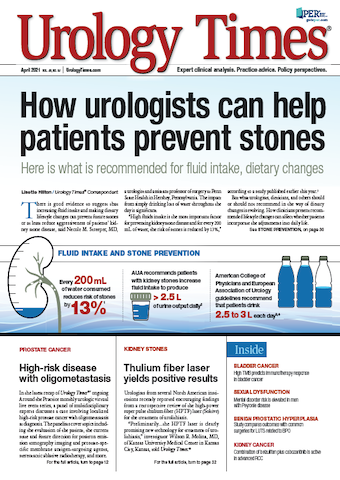Publication
Article
Urology Times Journal
Researchers report positive preliminary experience with super pulse thulium fiber laser lithotripsy
Author(s):
North American urologists analyzing outcomes from their initial experience treating urolithiasis with the high-power super pulse thulium fiber laser (Soltive) are encouraged by the results.
North American urologists analyzing outcomes from their initial experience treating urolithiasis with the high-power super pulse thulium fiber (HPTF) laser (Soltive) are encouraged by the results.1 Findings from their retrospective review that included 76 patients treated for a total of 118 upper urinary tract stones showed that the technology performed efficiently for ablating a variety of stone types and had a safety profile similar to the holmium:yttrium-aluminum-garnet (Ho:YAG) laser that is considered the current gold standard.
Details on patient characteristics, intraoperative data, and clinical outcomes are summarized in a paper published online in Urology. Wilson R. Molina, MD, professor of urology at Kansas University Medical Center in Kansas City, Kansas, was one of the treating urologists in the multicenter study and helped to develop the HPTF laser. He told Urology Times®, “The Ho:YAG laser, which has been around for more than 2 decades, is proven great technology for stone treatment, and its capabilities have been enhanced in recent years with the introduction of high-power lasers and pulse modulation. However, the HPTF laser offers several practical and technical advantages that give it the potential to be a real breakthrough in stone treatment.
“Experience with the HPTF laser is limited, we are still in the process of understanding how to optimize its parameters for treating different stone types, and there is a need for prospective randomized trials comparing the HPTF and Ho:YAG lasers. Preliminarily, however, the HPTF laser is clearly promising new technology for treatment of urolithiasis.”
Other centers contributing to the first North American HPTF laser series were Ohio State University, Columbus; University of British Columbia, Vancouver, Canada; and Mayo Clinic, Phoenix, Arizona. The 118 stones treated included 32 located within the ureter, and 49, 25, and 12 in the lower, mid-, and upper poles, respectively. Three-fourths of the procedures involved retrograde intrarenal surgery, dusting was the most common technique (67%), and most cases (79%) were done using a 200-μm fiber. Mean operative time approached 1 hour, mean laser time was 10.8 minutes, and total laser energy used was 12.5 kJ.
There were 11 intraoperative complications, all related to ureteral access sheath and none related to the laser itself. In addition, 1 patient developed renal collecting system bleeding that was controlled with laser coagulation settings. All patients had same-day discharge excluding 3 who developed sepsis. As assessed using ultrasound or CT scan, stone-free rates among patients who presented for follow-up were 67% at 6 weeks and 79% at 12 weeks.
Compared to the Ho:YAG laser, the HPTF laser is more portable, quieter, and can be installed without any special energy infrastructure requirements because it can be plugged into a conventional 120-V power outlet. From a technical perspective, the HPTF laser can be operated with a broader range of pulse energy and frequency settings that provides opportunity for optimizing lithotripsy. Because its 1940-nm wavelength is at the peak of water absorption and it is associated with less stone retropulsion, energy is delivered more efficiently with the HPTF laser. “Findings from laboratory studies and initial clinical experience indicate that when it comes to ablation efficiency, the HPTF laser is better than the Ho:YAG laser,” Molina said.
As another advantage, the HPTF laser seems to be associated with less fiber burn-back than the Ho:YAG laser, indicating the potential for the fibers to last longer. In addition, the HPTF laser can be used with smaller fibers that could potentially improve scope navigation and better irrigation flow. “Already HPTF procedures are being done with a 150-μm fiber whereas 200 μm is the smallest fiber that can be used with the Ho:YAG laser,” Molina said.
The features that distinguish the HPTF laser from the Ho:YAG laser, however, come with 2 sides to the coin. Because it causes less stone retropulsion, the HPTF laser will not perform as well as the Ho:YAG for the popcorn technique. In addition, the increased adjustability of the HPTF laser settings will likely make treatment parameter optimization more complex.
“We have to start from scratch to develop the best settings because we cannot extrapolate those used for Ho:YAG laser lithotripsy. With so much versatility, identifying the best settings for the HPTF laser will probably take more time,” Molina said.
Disclosure: Molina is a consultant for Olympus of the Americas.
Reference
1. Carrera RV, Randall JH, Garcia-Gil M, et al. Ureteroscopic performance of high power super pulse thulium fiber laser for the treatment of urolithiasis: results of the first case series in North America. Urology. Published online February 20, 2021. doi:10.1016/j.urology.2020.12.054































